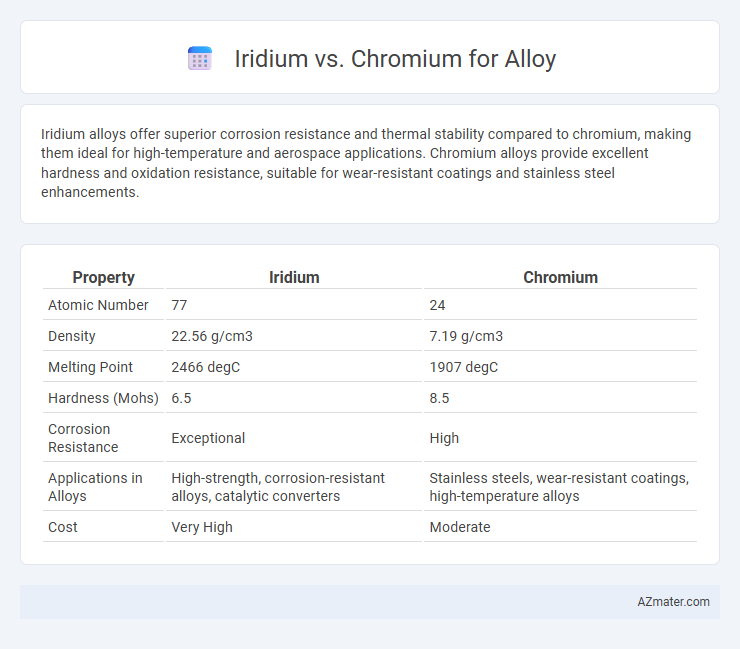Iridium alloys offer superior corrosion resistance and thermal stability compared to chromium, making them ideal for high-temperature and aerospace applications. Chromium alloys provide excellent hardness and oxidation resistance, suitable for wear-resistant coatings and stainless steel enhancements.
Table of Comparison
| Property | Iridium | Chromium |
|---|---|---|
| Atomic Number | 77 | 24 |
| Density | 22.56 g/cm3 | 7.19 g/cm3 |
| Melting Point | 2466 degC | 1907 degC |
| Hardness (Mohs) | 6.5 | 8.5 |
| Corrosion Resistance | Exceptional | High |
| Applications in Alloys | High-strength, corrosion-resistant alloys, catalytic converters | Stainless steels, wear-resistant coatings, high-temperature alloys |
| Cost | Very High | Moderate |
Introduction to Iridium and Chromium Alloys
Iridium alloys are renowned for their exceptional corrosion resistance and high melting point, making them ideal for use in extreme environments such as aerospace and chemical processing industries. Chromium alloys, on the other hand, are primarily valued for their hardness, wear resistance, and ability to enhance stainless steel's strength and oxidation resistance. Both elements are pivotal in alloy formulations, with iridium typically enhancing durability under high-temperature conditions and chromium improving mechanical properties and rust resistance.
Chemical Properties Comparison
Iridium exhibits exceptional corrosion resistance and high melting point (2446degC), making it ideal for alloys requiring durability under extreme conditions, while chromium's melting point is lower at 1907degC but its primary chemical property is forming a stable oxide layer that enhances corrosion resistance in stainless steel. Iridium is chemically inert and resistant to oxidation even at high temperatures, whereas chromium actively forms a protective chromium oxide film that prevents surface degradation. The key distinction lies in iridium's superior stability and hardness in harsh chemical environments compared to chromium's role in improving alloy corrosion resistance through passivation.
Mechanical Strength and Durability
Iridium alloys exhibit superior mechanical strength and exceptional durability, maintaining structural integrity under extreme conditions such as high temperatures and corrosive environments. Chromium alloys provide good hardness and corrosion resistance but typically lack the same level of tensile strength and toughness found in iridium-based materials. Iridium's higher melting point and resistance to oxidation make it more suitable for applications requiring long-term mechanical reliability and wear resistance.
Corrosion and Oxidation Resistance
Iridium offers superior corrosion resistance compared to chromium, especially in highly aggressive environments such as acidic and oxidizing conditions, due to its exceptional chemical inertness. Chromium provides good oxidation resistance and forms a protective oxide layer at elevated temperatures, but it is more susceptible to corrosion in acidic and chloride-containing environments. The choice between iridium and chromium alloys depends on the specific exposure conditions, with iridium favored for extremely harsh chemical environments and chromium preferred for cost-effective oxidation protection in moderately corrosive atmospheres.
Melting Points and Heat Resistance
Iridium exhibits a higher melting point of approximately 2,446degC compared to chromium's melting point of about 1,907degC, making it superior for applications requiring extreme heat resistance. In alloy compositions, iridium enhances high-temperature stability and corrosion resistance, whereas chromium contributes to hardness and oxidation resistance at moderately high temperatures. The exceptional heat resistance of iridium alloys is critical in aerospace and high-performance industrial settings where materials endure prolonged exposure to intense heat.
Applications in Industry
Iridium alloys offer exceptional corrosion resistance and high-temperature stability, making them ideal for use in aerospace components, electrical contacts, and spark plugs where durability under extreme conditions is critical. Chromium alloys are widely employed in stainless steel production, automotive parts, and industrial machinery due to their hardness, wear resistance, and ability to enhance corrosion resistance. The choice between iridium and chromium alloys depends heavily on the specific industrial application requirements involving temperature tolerance, mechanical strength, and environmental resistance.
Cost and Availability
Iridium is significantly more expensive and rarer than chromium, making it a less accessible option for alloy production despite its superior corrosion resistance and high melting point. Chromium is abundant, widely available, and cost-effective, which contributes to its prevalent use in stainless steel and other industrial alloys. The cost difference between iridium and chromium heavily influences alloy selection based on budget constraints and application requirements.
Alloying Behavior with Other Metals
Iridium exhibits exceptional corrosion resistance and maintains structural stability at high temperatures, making it ideal for alloying with platinum, osmium, and rhodium to enhance durability and hardness in extreme environments. Chromium, known for its strong oxidation resistance and ability to form stable carbides, is widely alloyed with iron, nickel, and manganese to improve wear resistance and tensile strength in stainless steels and superalloys. The distinct electron configurations influence their alloying behavior: iridium promotes superior high-temperature strength and corrosion resistance, while chromium primarily contributes to surface passivation and mechanical reinforcement.
Environmental Impact and Sustainability
Iridium and chromium alloys differ significantly in environmental impact and sustainability; iridium's extraction is energy-intensive with limited recycling options due to scarcity, resulting in a higher ecological footprint. Chromium, widely available and commonly used in stainless steel alloys, allows for efficient recycling and poses challenges related mainly to hexavalent chromium toxicity during processing. Sustainable alloy design increasingly favors chromium for its recyclability and lower resource depletion, while iridium's application is often reserved for specialized uses where extreme durability justifies its environmental costs.
Choosing the Right Alloy for Your Needs
Iridium alloys offer exceptional corrosion resistance and high melting points, making them ideal for high-temperature and chemical environments. Chromium alloys provide excellent hardness and wear resistance, suitable for applications requiring strength and durability. Selecting the right alloy depends on specific performance needs such as thermal stability versus mechanical wear resistance in your application.

Infographic: Iridium vs Chromium for Alloy
 azmater.com
azmater.com